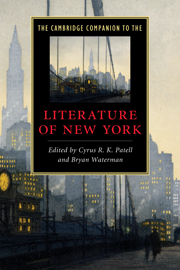Book contents
- Frontmatter
- Introduction
- 1 From British outpost to American metropolis
- 2 Dutch New York from Irving to Wharton
- 3 The city on stage
- 4 Melville, at sea in the city
- 5 Whitman’s urbanism
- 6 The early literature of New York’s moneyed class
- 7 Writing Brooklyn
- 8 New York and the novel of manners
- 9 Immigrants, politics, and the popular cultures of tolerance
- 10 Performing Greenwich Village bohemianism
- 11 African American literary movements
- 12 New York’s cultures of print
- 13 From poetry to punk in the East Village
- 14 Staging lesbian and gay New York
- 15 Emergent ethnic literatures
- Further reading
- Index
- Series list
11 - African American literary movements
Published online by Cambridge University Press: 28 November 2010
- Frontmatter
- Introduction
- 1 From British outpost to American metropolis
- 2 Dutch New York from Irving to Wharton
- 3 The city on stage
- 4 Melville, at sea in the city
- 5 Whitman’s urbanism
- 6 The early literature of New York’s moneyed class
- 7 Writing Brooklyn
- 8 New York and the novel of manners
- 9 Immigrants, politics, and the popular cultures of tolerance
- 10 Performing Greenwich Village bohemianism
- 11 African American literary movements
- 12 New York’s cultures of print
- 13 From poetry to punk in the East Village
- 14 Staging lesbian and gay New York
- 15 Emergent ethnic literatures
- Further reading
- Index
- Series list
Summary
Harlem, the first neighborhood famed as a global black metropolis, has stood for a century as this country's largest and most iconic black community. When this once white neighborhood became a black one, however, it was the sixth home in New York for African Americans before law and custom began to allow them access to the entire city. I often joke that whenever Europe sailed off to discover the rest of the world there was always an African aboard. In the case of New York, this was doubly true. A black Portuguese navigator came up the Hudson in 1525, and in 1613 Jan Rodriguez, a free black sailor, was dropped off from a Dutch trader on Manhattan and stayed.
The African influence on New York has its origins in the steady stream of people of African descent imported by the Dutch as slaves to build New Amsterdam. During the mid-1600s some held in bondage were freed and given land to provide a buffer zone against attacks from Native Americans at the northern end of New Amsterdam. When the British took over in 1664, thousands more captives were imported directly from West Africa into slavery in New York and a more repressive bondage than under the Dutch. The earliest African communities were near the present African Burial Ground and in the Five Points area. After the draft riots of 1863 a residential area known as “Little Africa” was in the West Village (until about 1890), and others developed in Brooklyn. From the 1880s until about 1910, most African Americans moved into the Tenderloin along Eighth and Ninth Avenues from 23rd Street to 42nd and San Juan Hill, between 58th and 65th Streets on the West Side.
- Type
- Chapter
- Information
- The Cambridge Companion to the Literature of New York , pp. 160 - 175Publisher: Cambridge University PressPrint publication year: 2010

